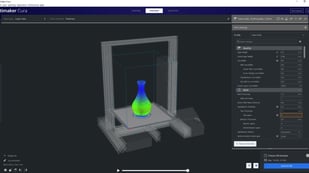

Using a brim helps me adhere the model to the build plate and ensure it does not shift and move in the printing process. Since miniatures have such a tiny surface areas of which to build from. If the model does not have a base I print using a Brim.When printing these models there are also a few things I almost always do. This way I build the figure up the leg while laying down filament and ensure a more sturdy and stable print. I could have just lowered the model but found that the ankle was sometimes too skinny and would cause the model to fail.

Looking at the image above you can see the curve of the foot and even talons of the Kobold are not flush.

Visually above shown unmodified file on left and prepped model for printing on the right.įor easier printing I rotated the kobold backwards 45 degrees AND lowered the model into the buildplate 0.2 mm to level out the heel of the model and give it some place for the model to grow on. Also although not obvious the talons were not flush with the build plate either and printing the tiny toe nails starting off are incredibly difficult.īlack Line indicates flush build plate. The curvature of the Kobold ankle made it extremely difficult to print as you does not provide a clean area to lay down a solid first layer and build upon. The largest issue of difficulty was its feet. The answer to this question takes time to practice but in the case of the Bottle Brawler yes there are a few areas that are difficult to print in filament.

“Is this model designed with filament printing in mind?” This is important as sculpts will sometimes utilize the strengths of a printer type or sculpt with the mentality for easier printing. When printing miniatures in filament I always think to myself first. Comment below if you have any of your own mental steps or questions.įor this example I am going to use a recently test printed model of the Bottle Brawler Kobold from the Lost Adventures Volume 3 Kickstarter which is running until August 31, 2021. If you are curious of my mental thought process for printing miniatures on FDM follow along below. Special Note: I highly suggest also selecting “Limit Support Retractions” under Travel as it will make it easier to remove supports if printing in larger groups. Printer: Currently Set to Prusa MK3s (Can be used on other types of printers)įilament: ESun PLA+ Grey (Current Favorite)
#Ultimaker cura tree support download
Print Profile: Download from Google Drive I do not know if versions older than 4.7.0 will work due to Tree Supports being moved from the experimental category to normal support settings. I will also discuss proper orientation and bed adhesion which can be a vital aid in printing your model while also being less dependent on your need of supports.Ĭurrently for printing my miniatures I print using Cura 4.8.0 but any newer version will work with my settings. While FDM support settings are crucial to the success and finished quality of your prints do not forget that print orientation is crucial. Here I will break down the my thought process when printing miniatures in FDM and support settings. So what do you do? Well you have come to the right place! However, presupported miniatures in FDM are not nearly as common as resin. One of the most difficult aspects of printing miniatures in either FDM or resin is of course supporting the model. Printing miniatures on a FDM printer can be difficult but it does not have to be a miserable process. QuickLinks: Support Settings, Step By Step, Tips & Tricks, Removing Supports, Want to Know MoreįDM Supported Kobold Bottle Brawler without Supports


 0 kommentar(er)
0 kommentar(er)
